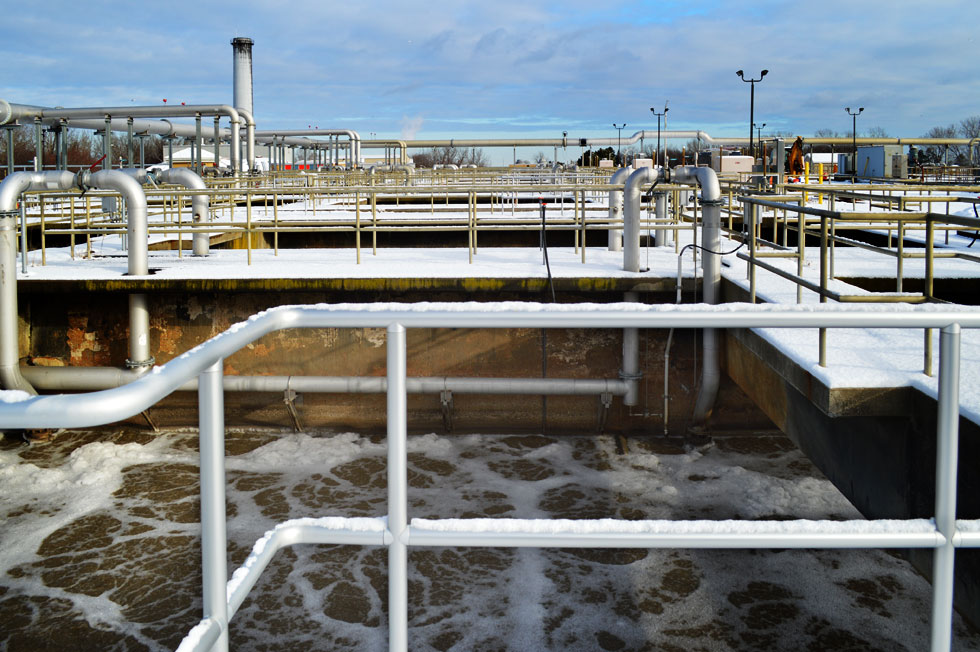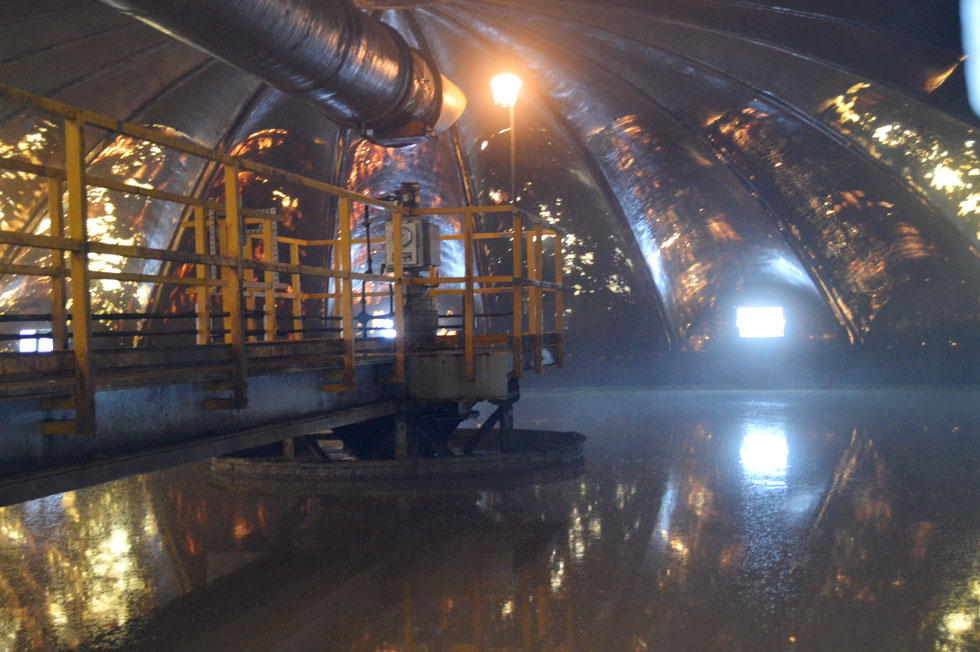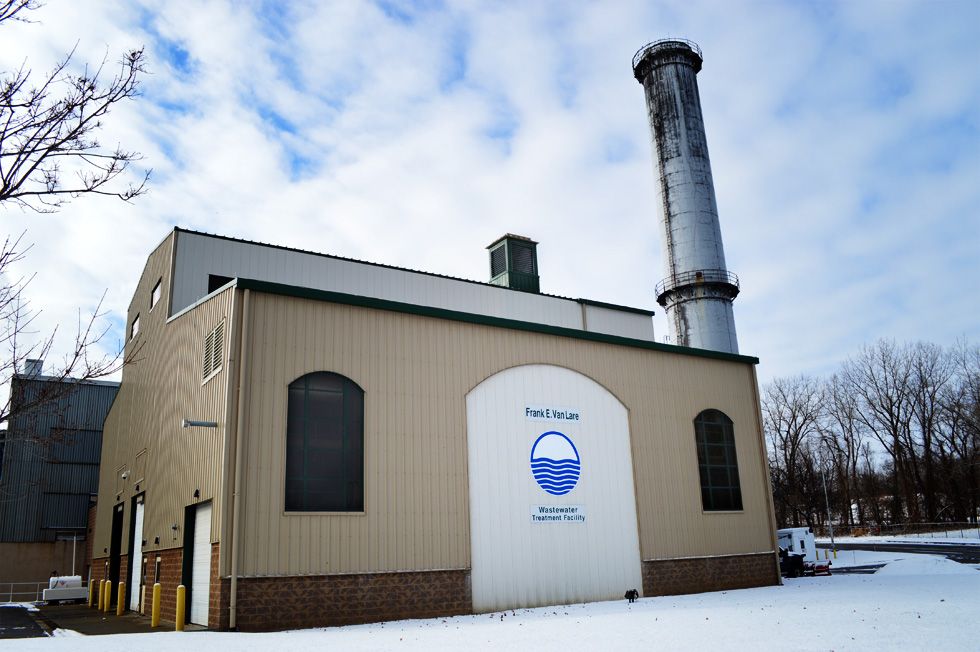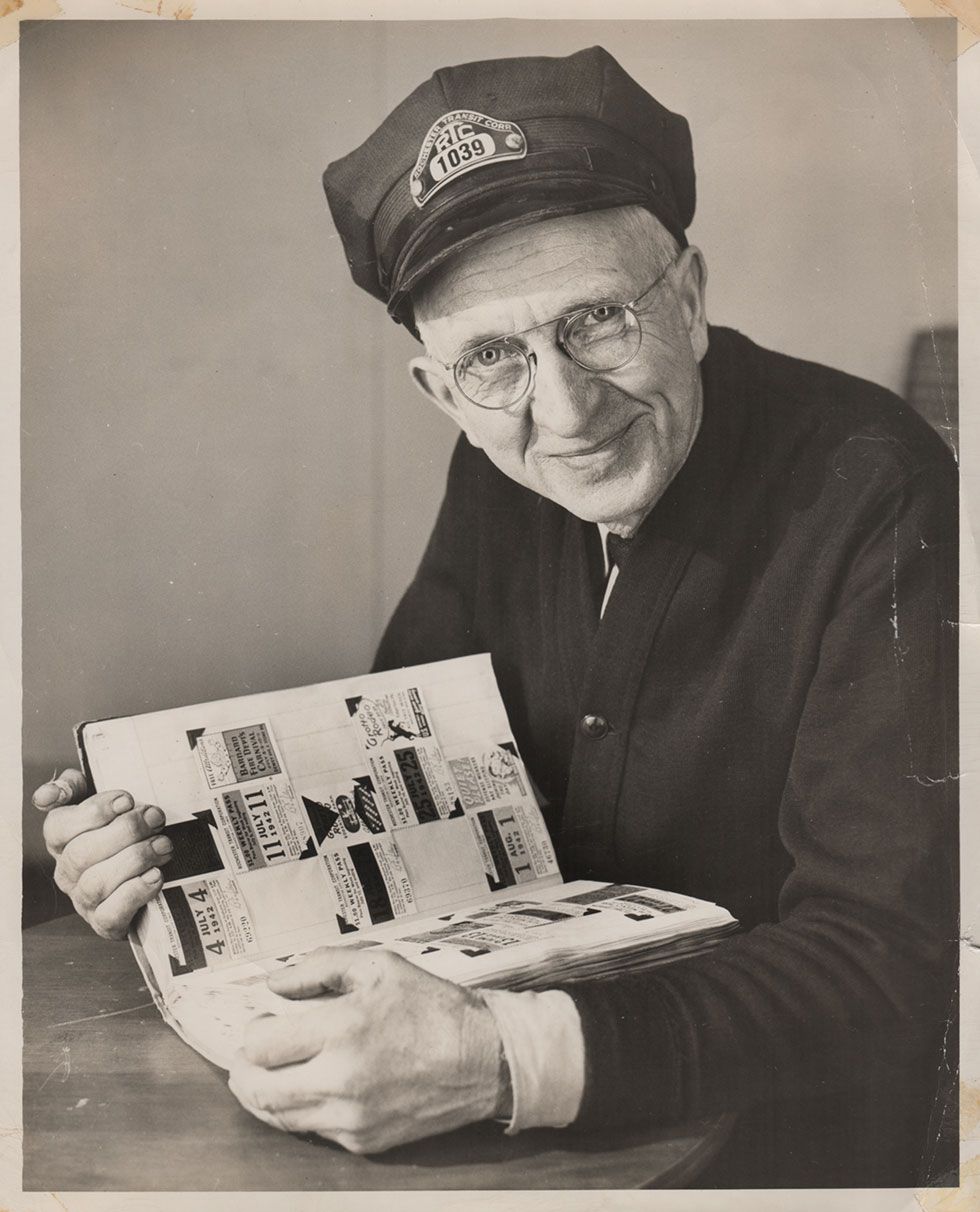This article was scraped from Rochester Subway. This is a blog about Rochester history and urbanism has not been published since 2017. The current owners are now publishing link spam which made me want to preserve this history.. The original article was published March 30, 2015 and can be found here.
![Grab your nose plugs. Today we're going inside Frank E. Van Lare Wastewater Treatment Facility. [PHOTO: RochesterSubway.com]](https://senseofplace.dev/content/images/photos/van-lare-water-treatment-plant-rochester-00.jpg)
Joe Henderson (34) was an earth science teacher at Rush Henrietta Central School District before graduating last year from University of Rochester with a Ph.D. in Education - with a focus on environmental education. Joe has taken many 8th graders on field trips to Frank E. Van Lare Wastewater Treatment Facility

. And today, he's arranged to bring all of you, RocSubway friends...
![Van Lare Wastewater Treatment Facility is one of those fascinating systems that keep our society humming along, yet largely unaware of. [PHOTO: RochesterSubway.com]](https://senseofplace.dev/content/images/photos/van-lare-water-treatment-plant-rochester-01.jpg)
Joe admits he's always had a fascination with the systems that keep our society humming along; the systems that we're dependent on, yet largely unaware of. "Van Lare is a really really interesting one," says Joe. "Both in terms of infrastructure and the environment." But on a more personal level, he explains that his dad was a public employee and that has shaped his understanding and appreciation for what is required to maintain the quality life we all enjoy today.
With so many, often politicized, debates about paying to keep our government running, Joe wanted to bring this story to RocSubway, in part for this reason. "I think it's important to point out that people actually do this work, and we pay them, and that's a GOOD thing for society to have. It's kind of sad that we have to have that conversation over and over again, but it's important."
* * *
History
![Construction of the filter at Allen's Creek Sewage Disposal Plant. The work was commissioned by the Brighton Sewer Commission and directed by the engineering firm of William S. Lozier. The plant discharged effluent into Allen's Creek. May 23, 1924. [PHOTO: Brighton Municipal Historian Collection]](https://senseofplace.dev/content/images/photos/allens-creek-sewage-disposal-plant-01.jpg)
As the City of Rochester and Monroe County grew and developed, our natural waterways were increasingly used to dispose of waste from homes, businesses and industry. In the early 1900s, water quality problems at Ontario Beach Park led in the development of Rochester's sewage system. Although wastewater management processes gradually improved, by the 1960s most of our major waterways were contaminated with unhealthy levels of pollution.
In the late 1960s federal money became available to combat these issues, and in 1971 Rochester's Pure Waters

agency was created to oversee a major upgrade of our waste water disposal system. The project, estimated to cost $550 million dollars and paid for by federal, state and local dollars, aimed to reduce the levels of pollution in Irondequoit Bay, the Genesee River, areas of Lake Ontario and other waters of Monroe County to safe and healthy levels.
To achieve this, wastewater needs to be collected, and pollutants removed, before it can be discharged back into the environment. Prior to 1970, there were approximately 40 wastewater treatment facilities in Monroe County. Those have all since been consolidated into five facilities, including Van Lare, that serve a population of over a half million.
* * *
Massive Infrastructure
![Bill Putt and his team give us a run down of Rochester's sewer system, and how this facility in particular works. [PHOTO: RochesterSubway.com]](https://senseofplace.dev/content/images/photos/van-lare-water-treatment-plant-rochester-02.jpg)
We meet up with some of the staff of Pure Waters at the control center inside the Van Lare facility. They give us the run down of the four sewage districts they manage (Northwest Quadrant, Rochester, Irondequoit South Central, and Gates-Chili-Ogden). This is an enormous and robust network including two wastewater treatment facilities, over 60 pump stations, 1,500 miles of sewer pipe, and 30 miles of major deep rock tunnels .
![The sewer system operated by Monroe County is spread over four sewer districts seen on the map at left: Northwest (yellow), Gates Chili Ogden (rust), Rochester (green), and Irondequoit Bay (blue). [IMAGE: Monroe County Environmental Services]](https://senseofplace.dev/content/images/photos/monroe-county-sewer-system-districts.gif)
The Van Lare treatment facility is located on the shore of Lake Ontario at Durand-Eastman Beach and dates back to 1916. It's the largest wastewater facility in the county, handling up to 135 million gallons per day (mgd) with a capability of handling 660mgd during storm events. By contrast, the Northwest Quadrant facility in the town of Hilton handles an average of 14mgd. * * *
Controlling the Uncontrollable
![Besides having a system of sewer pipes that carry wastewater to a treatment plant, cities and towns also need pipes to collect storm water. These are needed to prevent street flooding and usually lead directly to a waterway without any treatment. This is a shot from inside Rochester's combined sewer system under Norton Street. [PHOTO: Monroe County Environmental Services]](https://senseofplace.dev/content/images/photos/combined-sewer-system-tunnel-rochester.jpg)
Most of what we send down our drain pipes or gets flushed down our toilets is sent into the surface sewer system and is carried all the way to the treatment plant by way of gravity. All of that which is collected on the west side of the city flows to Van Lare across the Genesee River via two 6-foot pipes beneath the Maplewood pedestrian bridge. And everything collected from the east side of the city flows through a 16 foot tunnel from Tryon Park north through Durand-Eastman Park.
![The used water of a community is called wastewater. If it is not treated before being discharged into waterways, serious pollution will result. The photo at left depicts an overflow point of the Rochester City sewers into the Genesee River in the 1970s. [PHOTO: Monroe County Environmental Services]](https://senseofplace.dev/content/images/photos/genesee-river-sewer-overflow-rochester.jpg)
But portions of that surface system are uncontrolled. Meaning, when it rains, all the sewage plus rainwater can overwhelm the system and overflow, untreated, into our rivers and streams.
![Known as CSOAP (for Combined Sewer Overflow Abatement Program), these are deep rock tunnels (most between 6' - 16' in diameter) that collect overflow and store it until it can be sent to the treatment facility for processing. According to Bill, Rochester was the first city in the U.S. to build a CSOAP tunnel system like this. [PHOTO: RochesterSubway.com]](https://senseofplace.dev/content/images/photos/van-lare-water-treatment-plant-rochester-03.jpg)
Bill Putt manages the sewage collection system (everything coming into the plant). He explains that the Pure Waters program added an important layer of protection to save the system from being completely overrun during storms. Known as CSOAP (for Combined Sewer Overflow Abatement Program), these are deep rock tunnels (most between 6' - 16' in diameter) that collect overflow and store it until it can be sent to the treatment facility for processing. According to Bill, Rochester was the first city in the U.S. to build a CSOAP tunnel system like this.
175 Million gallons can be stored in the CSOAP system, but there are still major rain events that exceed this designed capacity. Last year for example, Bill says there were three severe storm events where street runoff overflowed to the river.
![Josephine Guarino manages the control center at Van Lare. This is essentially the brain of the entire system. Weather is constantly monitored, and tunnels and pump facilities can all be monitored and managed from here. [PHOTO: RochesterSubway.com]](https://senseofplace.dev/content/images/photos/van-lare-water-treatment-plant-rochester-04.jpg)
Josephine Guarino manages the control center at Van Lare. This is essentially the brain of the entire system. Weather is constantly monitored, and tunnels and pump facilities can all be monitored and managed from here.
If one section of the collection system fills to capacity, overflow can be redirected or held within the CSOAP tunnels using a series of cast iron control gates.
![This is a pumping station. If problems arise in the field--let's say an intruder breaks into one of these pumping stations--an alarm goes off in the control room and crews can be dispatched. [PHOTO: RochesterSubway.com]](https://senseofplace.dev/content/images/photos/van-lare-water-treatment-plant-rochester-05.jpg)
Or if problems arise in the field--let's say an intruder breaks into a pumping station like has happened at the one shown above--an alarm goes off in the control room and crews can be dispatched. * * *
Lost and Found
![This unassuming building is the first stop in the sewage treatment process. All of the sewage (and I mean ALL the sewage) enters the plant through this tiny building. [PHOTO: RochesterSubway.com]](https://senseofplace.dev/content/images/photos/van-lare-water-treatment-plant-rochester-06b.jpg)
This unassuming building is the first stop in the sewage treatment process. All of the sewage (and I mean ALL the sewage) enters the plant through this tiny building. It's pretty odorific

in here, so hold your noses.
![Tim (on the right) is one of the plant operators. He leads us through the entire process start to finish. [PHOTO: RochesterSubway.com]](https://senseofplace.dev/content/images/photos/van-lare-water-treatment-plant-rochester-06c.jpg)
Tim (on the right) is one of the plant operators. He leads us through the entire process start to finish.
![So down inside here the sewage passes through these metal screens. The screens catch any large debris as it comes in. [PHOTO: RochesterSubway.com]](https://senseofplace.dev/content/images/photos/van-lare-water-treatment-plant-rochester-09.jpg)
So down inside here the sewage passes through these metal screens. The screens catch any large debris as it comes in. Twigs, rags, plastic garbage, general unpleasantries, coins, wedding rings... you name it, it ends up here.
![Every so often a big rake comes down and scoops the junk out onto a conveyer belt here. [PHOTO: RochesterSubway.com]](https://senseofplace.dev/content/images/photos/van-lare-water-treatment-plant-rochester-07.jpg)
Every so often a big rake comes down and scoops the junk out onto a conveyer belt here.
![The belt dumps all the garbage into a dumpster at one end of the room. Things look pretty clean today. Tim says it looks much worse in the summer time. [PHOTO: RochesterSubway.com]](https://senseofplace.dev/content/images/photos/van-lare-water-treatment-plant-rochester-08.jpg)
The belt dumps all the garbage into a dumpster at one end of the room. Things look pretty clean today. Tim says it looks much worse in the summer time.
![The sewage then flows out here beneath these panels where it is aerated. The tiny bubbles will help any particulate matter settle out to the bottom of the channel. [PHOTO: RochesterSubway.com]](https://senseofplace.dev/content/images/photos/van-lare-water-treatment-plant-rochester-06.jpg)
The sewage then flows out here beneath these panels where it is aerated. The tiny bubbles will help any particulate matter settle out to the bottom of the channel.
![Take note of the life rings. If you ever need one of these, it's a bad day for you. [PHOTO: RochesterSubway.com]](https://senseofplace.dev/content/images/photos/van-lare-water-treatment-plant-rochester-11.jpg)
Take note of the life rings. If you ever need one of these, it's a bad day for you.
![This flow meter tells us an average of 32 Million gallons are flowing through here daily. [PHOTO: RochesterSubway.com]](https://senseofplace.dev/content/images/photos/van-lare-water-treatment-plant-rochester-10.jpg)
This flow meter tells us an average of 32 Million gallons are flowing through here daily.
![And there's a look at one of the massive sewage pipes. We're going to follow it to the next stop on our tour... [PHOTO: RochesterSubway.com]](https://senseofplace.dev/content/images/photos/van-lare-water-treatment-plant-rochester-12.jpg)
And there's a look at one of the massive sewage pipes. We're going to follow it to the next stop on our tour... * * *
Where the Magic Happens
![Now we come to an area about the size of a football field with a complex maze of compartments, channels, contraptions and doohickies. [PHOTO: RochesterSubway.com]](https://senseofplace.dev/content/images/photos/van-lare-water-treatment-plant-rochester-13.jpg)
Now we come to an area about the size of a football field with a complex maze of compartments, channels, contraptions and doohickies. This part gets a little confusing and I'm not sure I can match up each step in the process with the right photo, so I'm just going to summarize and then you can look at the photos and use your imagination a bit...
![First you've got your distribution box which sends the flow to all the various areas of the maze. [PHOTO: RochesterSubway.com]](https://senseofplace.dev/content/images/photos/van-lare-water-treatment-plant-rochester-14.jpg)
First you've got your distribution box which sends the flow to all the various areas of the maze.

Raw sewage isn't the only thing flowing through here. Billions of tiny micro-organisms (affectionately referred to as "good bugs") are swimming around in here helping to eat up all the bad poo poo and bacteria.
![In one area, oxygen is being added through an aeration process. The aeration helps particulates settle to the bottom where they can be separated out, and also adds oxygen for the good bugs. [PHOTO: RochesterSubway.com]](https://senseofplace.dev/content/images/photos/van-lare-water-treatment-plant-rochester-16.jpg)
In one area, oxygen is being added through an aeration process. The aeration helps particulates settle to the bottom where they can be separated out, and also adds oxygen for the good bugs.
![There's simply no way to describe how violent and nasty this is. [PHOTO: RochesterSubway.com]](https://senseofplace.dev/content/images/photos/van-lare-water-treatment-plant-rochester-17.jpg)
There's simply no way to describe how violent and nasty this is. So here's a video...
If only you could smell this and feel the spray hitting your face. It was great.
![If only you could smell this and feel the spray hitting your face. It was great. Tim says his immune system has gotten so strong after working here for 3 years that he can now drink this stuff as it is. [PHOTO: RochesterSubway.com]](https://senseofplace.dev/content/images/photos/van-lare-water-treatment-plant-rochester-21.jpg)
Tim says his immune system has gotten so strong after working here for 3 years that he can now drink this stuff as it is.
Just kidding. Do not attempt.
![I think this is another step in the aeration process but I can't remember exactly. If nothing else, it's a really neat hole. [PHOTO: RochesterSubway.com]](https://senseofplace.dev/content/images/photos/van-lare-water-treatment-plant-rochester-18.jpg)
I think this is another step in the aeration process but I can't remember exactly. If nothing else, it's a really neat hole.
![Tim did mention they're installing a new aeration system - switching from one like the one you might have in your fish tank, to one with ultraviolet (UV) bubbles. [PHOTO: RochesterSubway.com]](https://senseofplace.dev/content/images/photos/van-lare-water-treatment-plant-rochester-19.jpg)
Tim did mention they're installing a new aeration system - switching from one like the one you might have in your fish tank, to one with ultraviolet (UV) bubbles. This might be that. Sorry, we lost our notes.
![PEE and PEW? PEE stands for Primary Effluent East. The tanks on the other side are PEW; Primary Effluent West. Effluent is liquid waste. [PHOTO: RochesterSubway.com]](https://senseofplace.dev/content/images/photos/van-lare-water-treatment-plant-rochester-20.jpg)
PEE and PEW? Seem like fitting acronyms. Actually, PEE stands for Primary Effluent East. The tanks on the other side are PEW; Primary Effluent West. Effluent is liquid waste.
![These big circular things are skimmers. [PHOTO: RochesterSubway.com]](https://senseofplace.dev/content/images/photos/van-lare-water-treatment-plant-rochester-22.jpg)
These big circular things are skimmers. (BTW, you can click any of these photos for a larger view)
![While the solid waste particles settle to the bottom and form sludge, grease naturally floats to the surface. So these giant skimmers slowly rotate, collecting the greasy surface scum. [PHOTO: RochesterSubway.com]](https://senseofplace.dev/content/images/photos/van-lare-water-treatment-plant-rochester-24.jpg)
While the solid waste particles settle to the bottom and form sludge, grease naturally floats to the surface. So these giant skimmers slowly rotate, collecting the greasy surface scum.
![Another rotating rod at the bottom collects the sludge to be pumped into those big brown domes you see in the background. [PHOTO: RochesterSubway.com]](https://senseofplace.dev/content/images/photos/van-lare-water-treatment-plant-rochester-27.jpg)
Another rotating rod at the bottom collects the sludge to be pumped into those big brown domes you see in the background.
![Those are called Gravity Thickeners. Let's take a peak inside... [PHOTO: RochesterSubway.com]](https://senseofplace.dev/content/images/photos/van-lare-water-treatment-plant-rochester-41.jpg)
Those are called Gravity Thickeners. Let's take a peak inside...
![Go on. Don't be scared. All the way in you go... [PHOTO: RochesterSubway.com]](https://senseofplace.dev/content/images/photos/van-lare-water-treatment-plant-rochester-42.jpg)
Go on. Don't be scared. All the way in you go...
![As you can imagine, this is one of the worst smells I've ever smelled in the history of smelling. We're now looking down upon 50,000 gallons of watery you-know-what. [PHOTO: RochesterSubway.com]](https://senseofplace.dev/content/images/photos/van-lare-water-treatment-plant-rochester-43.jpg)
As you can imagine, this is one of the worst smells I've ever smelled in the history of smelling. We're now looking down upon 50,000 gallons of watery you-know-what.

As more and more of the slurry is pumped into here, gravity pulls the solid matter downward where it gets thicker and thicker - hence the name, "Gravity Thickener". The sludge is then pumped out through the bottom, while any remaining water stays up top and gets fed back around into the distribution boxes to be treated again.
Holy heck, besides the stench, it's warm and very damp in here. Let's get out while we still can...
![Don't worry, we'll come back to the sludge slurry in a moment. Right now let's follow the water to the last leg of it's journey. [PHOTO: RochesterSubway.com]](https://senseofplace.dev/content/images/photos/van-lare-water-treatment-plant-rochester-25.jpg)
Don't worry, we'll come back to the sludge slurry in a moment. Right now let's follow the water to the last leg of it's journey. * * *
Return to the Wild
![It's strange to think that all of this water will eventually be returned to the natural environment, back into the water cycle where it will be consumed all over again. But that's exactly where it's headed. [PHOTO: RochesterSubway.com]](https://senseofplace.dev/content/images/photos/van-lare-water-treatment-plant-rochester-26.jpg)
It's strange to think that all of this water will eventually be returned to the natural environment, back into the water cycle where it will be consumed all over again. But that's exactly where it's headed.
![At this point the water goes through a final disinfection process. Sodium hypochlorite (a.k.a. hospital grade bleach) is introduced into these channels. [PHOTO: RochesterSubway.com]](https://senseofplace.dev/content/images/photos/van-lare-water-treatment-plant-rochester-28.jpg)
At this point the water goes through a final disinfection process. Sodium hypochlorite (a.k.a. hospital grade bleach) is introduced into these channels.
![The flow of water is slowed down quite a bit by the baffles so it has contact time with the sodium hypochlorite. [PHOTO: RochesterSubway.com]](https://senseofplace.dev/content/images/photos/van-lare-water-treatment-plant-rochester-29.jpg)
The flow of water is slowed down quite a bit by the baffles so it has contact time with the sodium hypochlorite. And then...
![And at the very end of this maze is the outflow pipe into Lake Ontario. [PHOTO: RochesterSubway.com]](https://senseofplace.dev/content/images/photos/van-lare-water-treatment-plant-rochester-30.jpg)
And at the very end of this maze is the outflow pipe into Lake Ontario.
![This pipe goes about 3.5 miles into the lake where the treated water is released back into the wild. [PHOTO: RochesterSubway.com]](https://senseofplace.dev/content/images/photos/van-lare-water-treatment-plant-rochester-31.jpg)
This pipe goes about 3.5 miles into the lake where the treated water is released back into the wild.
![Here, facility operators run Chlorine residual tests 24/7 to verify that the disinfecting dose of Sodium hypochlorite is just right. Pink = Good. [PHOTO: RochesterSubway.com]](https://senseofplace.dev/content/images/photos/van-lare-water-treatment-plant-rochester-32.jpg)
Here, facility operators run Chlorine residual tests 24/7 to verify that the disinfecting dose of Sodium hypochlorite is just right. Pink = Good.
![And Joe does his own test. MMMMM... that's good water. [PHOTO: RochesterSubway.com]](https://senseofplace.dev/content/images/photos/van-lare-water-treatment-plant-rochester-33.jpg)
And Joe does his own test. MMMMM... that's good water. * * *
Sludge Cake
![Alrighty, now let's go see what happens to the left over solid waste. [PHOTO: RochesterSubway.com]](https://senseofplace.dev/content/images/photos/van-lare-water-treatment-plant-rochester-34.jpg)
Alrighty, now let's go see what happens to the left over solid waste.
![We're going to walk through a series of long underground tunnels following a mess of pumps and pipes through which our sludgy scum is sucked through. [PHOTO: RochesterSubway.com]](https://senseofplace.dev/content/images/photos/van-lare-water-treatment-plant-rochester-35.jpg)
We're going to walk through a series of long underground tunnels following a mess of pumps and pipes through which our sludgy scum is sucked through.
![We're going to walk through a series of long underground tunnels following a mess of pumps and pipes through which our sludgy scum is sucked through. [PHOTO: RochesterSubway.com]](https://senseofplace.dev/content/images/photos/van-lare-water-treatment-plant-rochester-36.jpg)
![Check out the yellow pipe labeled CHL. SOL. [PHOTO: RochesterSubway.com]](https://senseofplace.dev/content/images/photos/van-lare-water-treatment-plant-rochester-37.jpg)
Check out the yellow pipe labeled CHL. SOL.
![These once carried straight chlorine solution. Chlorine at high concentrations like this would be very dangerous stuff. [PHOTO: RochesterSubway.com]](https://senseofplace.dev/content/images/photos/van-lare-water-treatment-plant-rochester-38.jpg)
These once carried straight chlorine solution. Chlorine at high concentrations like this would be very dangerous stuff. It was even used in World War I as the first gaseous chemical warfare agent. Fortunately, it's no longer used here.
![I forget exactly what Tim said these things are. I think the sticker says it all though. [PHOTO: RochesterSubway.com]](https://senseofplace.dev/content/images/photos/van-lare-water-treatment-plant-rochester-39.jpg)
I forget exactly what Tim said these things are. I think the sticker says it all though.
![I forget exactly what Tim said these things are. I think the sticker says it all though. [PHOTO: RochesterSubway.com]](https://senseofplace.dev/content/images/photos/van-lare-water-treatment-plant-rochester-40.jpg)
![Ok, now we come to a room with several big, multi million dollar centrifuges. The sludge is pumped in and spun around real fast so as to squeeze out any remaining drops of water that haven't already been removed. [PHOTO: RochesterSubway.com]](https://senseofplace.dev/content/images/photos/van-lare-water-treatment-plant-rochester-45.jpg)
Ok, now we come to a room with several big, multi million dollar centrifuges. The sludge is pumped in and spun around real fast so as to squeeze out any remaining drops of water that haven't already been removed.
![The water is sent back through the treatment process, and I kid you not, the resulting byproduct is called 'sludge cake'. [PHOTO: RochesterSubway.com]](https://senseofplace.dev/content/images/photos/van-lare-water-treatment-plant-rochester-46.jpg)
The water is sent back through the treatment process, and I kid you not, the resulting byproduct is called "sludge cake".
![This sludge cake is then pumped into the next room where a couple of sludge hauling trucks are waiting to be loaded up and driven off to the Mill Seat Landfill in Riga, NY. You can barely see the tail lights of one of the trucks in this photo. [PHOTO: RochesterSubway.com]](https://senseofplace.dev/content/images/photos/van-lare-water-treatment-plant-rochester-47.jpg)
This sludge cake is then pumped into the next room where a couple of sludge hauling trucks are waiting to be loaded up. You can barely see the tail lights of one of the trucks in this photo.
The sludge cake will be taken to a factory where it will be made into Wegmans Ultimate Chocolate Cake.
NO NO! I got you again. It's actually trucked to the Mill Seat Landfill

in Riga. Of course.
![Once at the landfill, the sludge will be mixed in with the garbage helping to break it down, and also creating methane which is used to fuel generators, that return power to the electric grid, so that we can light our homes and play 'Circle of Life' by Elton John while drinking abundant amounts of life-giving water. Ahhh! Thank you Pure Waters! [PHOTO: RochesterSubway.com]](https://senseofplace.dev/content/images/photos/van-lare-water-treatment-plant-rochester-48.jpg)
Once at the landfill, the sludge will be mixed in with the garbage helping to break it down, and also creating methane which is used to fuel generators, that return power to the electric grid, so that we can light our homes and play Circle of Life

by Elton John while drinking abundant amounts of life-giving water.
Ahhh! Thank you Pure Waters!
And thank you Joe Henderson, for arranging this tour.
* * *
You're interested in environmental science, why not follow Joe on Academia.edu

and Twitter

?


